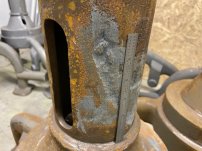Found an instruction book and it confirms that this is the stuff.
Mix with water.
144 p., ill., 15 cm., trade catalog
archive.org
Smooth-On says they quit making it in about the 1980s.
Occasionally get a call about it, but quit making it when there was no longer a market for it.
They do not have any lost in a warehouse.
They would not tell, or sell, the proprietary details.
Some of the chemicals in it are not legal to possess, I'm thinking asbestoes.
They would not mix up a batch, have no way to do it, and have nothing similar to offer.
An ebay search brings up many companies making what they call Iron Cement, partial cans being sold as antique displays.
One can says contains plaster of paris...
Yeah, yeah, wake up, it's a modern world, but I'm a dog on a hunt and I seldom stray from the Antique section of this website, anyway.
With so many companies having made a similar product, there must be some modern desire for it still, somewhere in the world.
I'm old enough that the 1980s is NOT that long ago.
...furnace cement seems to fit the bill, but does it contain sand ?, like has been mentioned to be hard on cutters.
Mike





